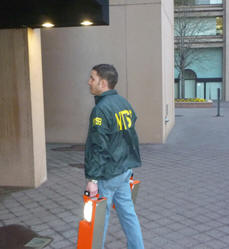|
|||||||||||||||||
|
|
|
|||
|
NTSB
Investigating Southwest Airlines Rupture And Depressurization Event By Mike Mitchell |
||||
 |
April 4, 2011 - The National Transportation Safety Board
is investigating an in-flight fuselage rupture that
occurred on Friday evening on a Southwest Airline,
Flight 812, Boeing 737 aircraft (N632SW). The damaged
airplane diverted and landed safely in
Southwest Airlines is working with the National
Transportation Safety Board (NTSB) to determine the
cause of the rupture which leaded to a rapid
depressurization of the aircraft.
Further, the carrier has decided to keep a subset of its
Boeing 737 fleet out of the flying schedule to begin an
aggressive inspection effort in cooperation with Boeing
engineers.
"The safety of our Customers and Employees is our
primary concern, and we are grateful there were no
serious injuries," said Mike Van de Ven, Southwest's
executive vice president and chief operating officer.
|
|||
| The flight recorders from Southwest flight 812 | ||||
|
There were
118 passengers on board and five Phoenix-based crew members
aboard Flight 812. Preliminary reports indicated the aircraft
lost pressure and oxygen masks were deployed. After the plane
landed safely in
One flight
attendant was treated at the scene for a minor injury, as was at
least one passenger. No injuries required transport to the
hospital. The Company arranged for a Southwest Airlines aircraft
to transport the Customers from
Southwest
is working with Boeing on an inspection regimen for the 81
affected Boeing 737 aircraft in the fleet, which are covered by
a set of Federal Aviation Administration Airworthiness
Directives aimed at inspections for aircraft skin fatigue. These
aircraft will be inspected over the course of the next several
days. On Saturday Southwest has cancel approximately 300 flights
to accommodate the inspections.
"The safety of our Customers and Employees is our primary concern," said Mike Van de Ven, Southwest's executive vice president and chief operating officer. "We are working closely with Boeing to conduct these proactive inspections and support the investigation. We also are working aggressively to attempt to minimize the impact to our Customers' travel schedules today." |
||||
|
The 118 passengers
on board Flight 812 have received a full refund along with an apology
and two complimentary roundtrip passes on Southwest for future flights.
One flight
attendant was treated at the scene for a minor injury, as was at least
one passenger. No injuries required transport to the hospital. The
Company arranged for a Southwest Airlines aircraft to transport the
Customers on Flight 812 from
As of 4 p.m.
Central time Sunday, 19 planes had undergone the intense inspection with
no findings, and those planes have been returned to service. In two
other airplanes, the testing did detect small, subsurface cracks.
Further evaluation and potential repairs will be necessary before those
planes are returned to service. Inspections
of the remaining aircraft in the sub-fleet (79 total) will continue for
the next few days. As inspections are completed with no findings, those
planes will continue to be put back into service.
The airline
anticipates completing the inspections by late Tuesday. The 79 aircraft
designated for the additional inspections were designed differently in
the manufacturing process. On Sunday, Southwest had cancelled
approximately 300 flights while the inspections are ongoing.
"I could not be
more proud of our Maintenance and Engineering professionals who
supported Boeing and the FAA in the establishment of these new
inspection procedures," said Mike Van de Ven, Southwest's Executive Vice
President and Chief Operating Officer. "Boeing has since identified an
inspection program for this section of the aircraft. Based on this
incident and the additional findings, we expect further action from
Boeing and the FAA for operators of the 737-300 fleet worldwide."
Southwest operates
a total 737 fleet of 548 planes. The fleet is constantly undergoing
rigorous checks and inspections as directed by the FAA and Boeing, the
aircraft manufacturer. These checks and inspections are dictated by
number of cycles (a cycle is a takeoff and landing) and on a calendar
basis as well.
"Our highest priority is the safety of our Employees and Customers," Van de Ven said. "Prior to the event regarding Flight 812, we were in compliance with the FAA-mandated and Boeing-recommended structural inspection requirements for that aircraft. ?What we saw with Flight 812 was a new and unknown issue. We regret any Customer inconveniences as a result of the inspections currently underway. Delays and cancelations are never the preference, however we are taking every precaution we can to ensure that our operation is safe."
Mechanics from Southwest Airlines, under the supervision of NTSB
investigators, removed a section of the ruptured fuselage skin. The
segment has be transported to NTSB headquarters in
In addition, NTSB investigators conducted additional inspections of
other portions of the lap joint along the fuselage of the accident
airplane and found evidence of additional cracks.
The NTSB, along with the other investigative parties - FAA, Boeing, and
Southwest Airlines - has been working to determine what actions might be
necessary to inspect any similar airplanes. |
|
|
| ?AvStop
Online Magazine
Contact
Us
Return To News
|
|

